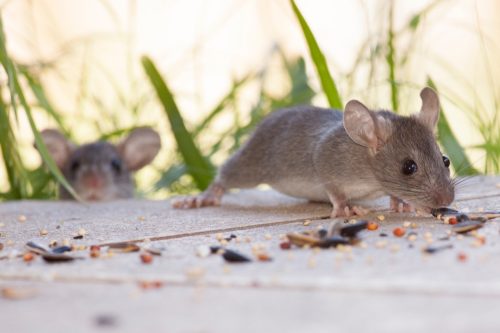Seeing Stray Cats in Your Yard? Here’s Why They’re Lurking Around Now

You might be wondering why it matters if stray cats are attracted to your yard. They’re not scary and dangerous like snakes; they don’t bite like mosquitoes; and they aren’t gross like rats. But they’re still animals and can disrupt your outdoor space. Not to mention, if you have cats of your own, strays can startle them and mark their territory, which can cause behavioral issues in your pet. That’s why we spoke to animal and home experts to find out what is drawing stray cats to your space. Read on for their thoughts and advice.
RELATED: 6 Plants That Keep Deer Out of Your Yard, According to Experts.
1
Food

For almost any animal or pest, food is going to be the number one thing attracting them anywhere, and cats are no exception.
“This might include leftovers in your pets’ bowls if you feed them outside, or it could be your garbage cans, grills, and picnic leftovers,” says Nicole Carpenter, CEO of Black Pest Prevention.
Carpenter also points out that stray cats could be coming to your yard because of past food sources: “Cats have excellent memories and can easily recall where they’ve found something particularly tasty.”
2
Prey

It’s not just human food that attracts hungry cats; other animals and insects that they prey on could also be a factor.
Carpenter points to birds in particular. “If you enjoy feeding birds and have birdhouses and feeders, rest assured that stray and neighborhood cats will eventually be drawn to your property because they can’t resist such a temptation,” she says.
Mice and other small rodents can also “attract cats looking to hunt,” notes home improvement specialist Joshua Bartlett, owner and editor-in-chief of I’ll Just Fix It Myself.
RELATED: 8 Things in Your Yard That Are Attracting Snakes to Your Home.
3
Water

Of course, just as important as food to a cat is water. “A birdbath, fountain, or even a dripping faucet can attract them to your yard,” says Bartlett. Other sources include your pet’s water bowls or any standing water that accumulates on patio sets or outdoor toys.
4
Certain plants

While it’s not likely that you have catnip growing in your backyard, other plants attract cats, too. According to Carpenter, these include wheatgrass, rosemary, valerian, and chamomile.
Your vegetable garden could also be a draw, as the Los Angeles Times explains that cats are typically attracted to plants that are high in vitamins and minerals. “Parsley is a favorite that provides vitamins A, B, C and beta carotene, potassium and other minerals, while carrot tops contain Vitamin A and beta carotene, and spinach is high in calcium and Vitamins C and A,” the publication notes.
RELATED: 8 Foods That Are Attracting Mice Inside Your Home.
5
Hiding spots and warmth

If you’ve ever lived with an indoor cat, you know that they seek out any cozy place to curl up, whether it’s a cardboard box or inside your closet. Outdoor cats also enjoy hiding spots, which serve the additional purpose of providing warmth when temperatures drop.
“Cats are naturally drawn to places where they can find shelter and warmth,” shares Bartlett. “This includes under decks, in sheds, or other cozy nooks in your yard. They may also be drawn to heat sources like car engines, especially in colder weather.”
“Bushes, dense plantings, or open barns and other spaces can be appealing to cats seeking temporary shelter,” adds Carpenter.
6
Other cats

If you have your own feline pets, strays may be attracted to your yard. “They are drawn to the scent marks left by other cats,” notes Bartlett.
Carpenter adds that they could be seeking a mating partner. “Cats, especially males, are drawn by the hormonal scent of their trusted partners. Unless you have a neutered or spayed animal at home, you may find neighbor cats in your yard frequently,” she explains.
RELATED: 5 Scents That Attract Raccoons to Your Yard, Experts Say.
What to do if you find a stray cat in your yard

It’s understandable why you may not want stray cats roaming in your backyard, but it’s important to take the correct steps if you do see one, especially if they appear sick, injured, or malnourished.
“The first thing you should do is provide him with food and water,” suggests Susan Nilson, a cat and dog training and behavior expert and the founder of The Cat and Dog House. “If he runs away and hides or is too scared to let you approach him, you can leave food and water outside and create a shelter for him from a cardboard box or similar.”
Then, if the cat has an ID tag, you’ll want to contact its owner. If not, Nilson says you have the option to take the cat to the vet, so they can see if it’s microchipped. “You can always reach out to your local animal rescue or shelter for advice and support,” she adds.
However, as Stephen Quandt, founder of Stephen Quandt Feline Behavior Associates, notes, you must be careful if a stray cat is feral, a term that “refers to cats who were never socialized to people and generally can’t be touched, ever.”
Another thing you’ll want to look for is whether or not the cat has a clipped, or “tipped,” ear. “This is universal language, a message to other rescuers that the cat was ‘TNR’d,’ meaning trapped, neutered, and returned and should be left alone,” Quandt explains.
He also points out that certain stray cats are considered “community cats,” which means they should not be relocated. “Progressive animal welfare organizations define a community cat as a healthy, reasonably safe, spayed or neutered cat who is being cared for by members of the community,” he shares.
For more home and yard tips sent right to your inbox, sign up for our daily newsletter.